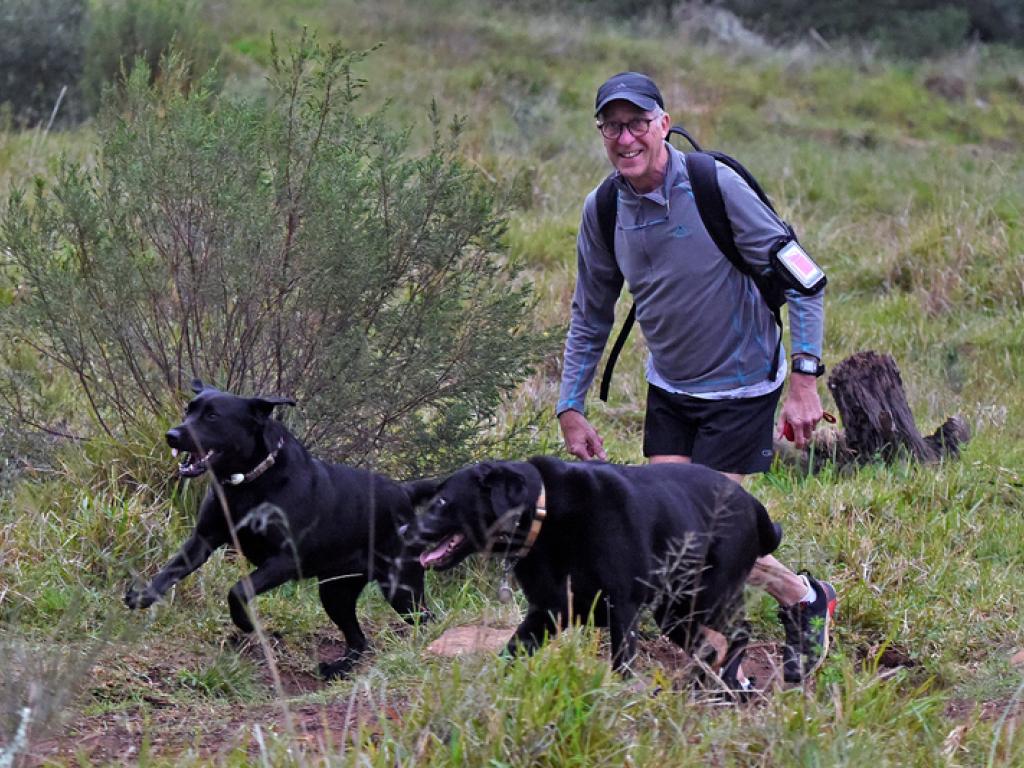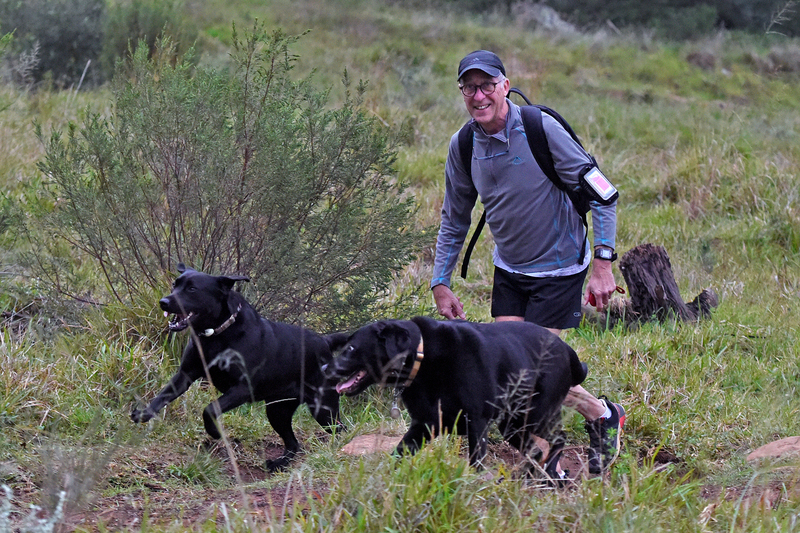Chocolate, humour help the medicine go down


Prof Mike Meadows, Harriet and Maisy head up to the Tafelberg Road track, where the student field trip introduces first-years to key elements of the course. Photo: Brenton Geach
Every first semester for the past 33 years, Professor Mike Meadows has delivered the 09:00 first-year lecture on physical geography. At the end of last semester, he gave his “swansong” performance.
In December, Meadows will retire but will take on the mantle of senior research scholar, part of a cohort of emeritus professors who act as mentors to the University of Cape Town’s (UCT) next generation of scholars.
It’s not been the same lecture, mind. Things have changed since 1986 when Meadows first joined the Department of Environmental & Geographical Science. Back then a litre of fuel cost 37 cents, a cup of coffee 45 cents, and a loaf of bread 53 cents.
“I’ve never missed it. Even when I’ve taken a sabbatical, I’ve always timed it for the semester we didn’t run the course,” he recalled.
Since the late 1990s, the class has been taught jointly by colleagues in geology and archaeology; technology has changed how information is shared, and the face of the class has transformed (although not the culture of skipping Friday lectures).
But the fundaments of the geography curriculum haven’t.
“We’re still teaching basic understanding of landscape and landform processes, and patterns in the landscape,” he said.
The first part of the course covers fundamental geology, from the Big Bang to the structure of the Earth; the rocks, a bit on the environment too, like mining.
“I’ve never missed it. Even when I’ve taken a sabbatical, I’ve always timed it for the semester we didn’t run the course.”
“My role then starts with a section (‘Shape of the Earth’) about the landforms that are draped over that geological skeleton. The second section is about the lifeforms on it (‘Life on Earth’), with the Western Cape landscape being the illustration of those things.”
Spot prizes
Today, Meadows sits in an armchair in his office on the fourth level of the ENGEO Building, an island among teetering stacks of exam scripts, marking pen in hand.
“I’m on sabbatical but you wouldn’t think so,” he said wryly.
“I’ve been doing this since Monday. I should be finished by Friday [it’s Thursday],” he added, lamenting the rote learning that has followed many students from school.
“This is the pinnacle of my joy … not having to do this ever again!”
He prefers the part of his job that brings the excitement and wonder of the physical world to a class of 270 students.
He describes himself as an old-fashioned, linear, topic-oriented lecturer. But there’s little stiffness; his hallmarks have been approachability (especially to the student who holds biblical fundamentalist views on the age of the Earth) and his British humour.
“There have to be jokes, otherwise the lecture doesn’t go well. There’s nothing that gives me more confidence than hearing them laugh, usually at me, which is fine.
“You have to be sensitive, and not in a politically correct way. One of the things I’ve retained from my upbringing in England is a love of Everton FC [he’s passionate about sport and served as UCT Sports Council chair], which is a painful, terrible experience because they’re not very good, certainly not compared with great rivals Liverpool.
“I still hark back to that Everton thing. I can’t start the class without telling them: This is who I am, this is the team I support…”
Chalk and talk
After college in England he came to South Africa in 1983 and joined UCT after two years at Rhodes. Then, lecturers used a blackboard or overhead projectors.
“They had some limitations but also advantages because it kind of slowed the pace a bit.”
“To be able to show examples of the landscape and landforms and processes I’m teaching has been hugely advantaged by data projection.”
But the ability to project data and images changed everything, especially as he teaches physical geography.
“To be able to show examples of the landscape and landforms and processes I’m teaching has been hugely advantaged by data projection. It wasn’t impossible in the old days because we had those 35 mm slide projectors which would inevitably fail, and yes, it was clumsy.
“Now we record lectures. But I’ve always given permission for my lectures to be recorded… This has a massive advantage for the student who wants to revise, review, or if they miss a lecture. But the side effect has been a massive drop-off in attendance.”
He has a neat solution for that.
Bribery.
Students know there will be a post-lecture quiz and those who are attentive – and quick – will get chocolate bars.
“Spot prizes,” Meadows said.
“I do it on a Friday. Friday’s always been terrible attendance.”
Tafelberg Road
Field trips are also vitally important as teaching tools.
Meadows religiously takes his students along the single track at the back of Table Mountain. It’s a “living” lesson: one of the planet’s oldest mountains, six times older than the Himalayas and five times older than the Rockies. Its creation begins 800 million years ago when sandstone began to form underwater.
“The students love it and hate it all at once. Many have never been up before, many are unfit. I always take at least one of the dogs.”
“Spot prizes … I do it on a Friday. Friday’s always been terrible attendance.”
These have been a succession of black Labradors, now Maisy and Harriet (Harry), who also feature in his teaching visuals.
“Here’s Harry for scale, here’s Maisy for scale.”
In student evaluations, it’s the Tafelberg Road field trip that stands out.
“They remember it years later. Rain or shine. We’ve only once abandoned it. That was a Friday afternoon and it was howling, a proper northwester. I was worried someone might get blown off the path.”
After 33 years, climate change has begun to irrevocably shape the curriculum.
“We’ve become much more aware of environmental issues,” said Meadows. Sadly “climate change” has become shorthand for too many other things. It doesn’t cover myriad environmental issues to do with the overuse of resources.
“I’ve never been an environmental evangelist, never been ‘out there’ in that sense, but I’ve always tried to instil a sense of wonder in my class about the environment, because we live in the most extraordinary part of the planet from this perspective.”
Meadows pulls up a picture of the Cape Flats at daybreak, taken from the back of Table Mountain, stretching to False Bay, mist concealing the urban landscape between a rim of hill and mountain.
“This is on our doorstep. I use that as the catch for the course: These are our landscapes first, and if we can understand them we can appreciate them even more.”
He paused.
“I must say none of that comes through in the exam [scripts]. Clearly the exam environment doesn’t encourage romantic thoughts…”
Careers
Careers in geography have changed too. Once, students took geography (or history) and physical education to become teachers.
“Few do it now. The big shift has been in the direction of a broadening base of careers. Geography doesn’t tie you down or direct you particularly. Students end up in a wide range of things: as environment impact assessors or as environmental professionals – for example, in mining.”
Another big growth area is in geo-information systems (GIS).
“The power of digital information is huge and we’re just beginning to think about unlocking that power in the curriculum. You can just see so much more, measure so much more from space … it’s so powerful.”
“The power of digital information is huge and we’re just beginning to think about unlocking that power in the curriculum.”
Meadows also spends four months a year at the East China Normal University, which has a research centre on an island in the Yangtze estuary. The island is intended to become an icon in the Chinese government’s new drive to become an eco-civilisation.
He has a major joint research project there, funded by the Chinese and the National Research Foundation.
“It’s a great opportunity for our students,” Meadows said.
“I recently had four working with me for a month, plus a postdoc who will go back with me possibly [this month] or October.”
Meadows’s wife Alison, and good friends Dr Pippin Anderson and Associate Professor Frank Eckardt, were there to share his last lecture.
“They were just after the chocolates,” Meadows quipped.
“It felt quite emotional. But the thing that pleased me most was the students who came down to the front at the end to thank me. All were women of colour… I was very overcome by that as much as anything else, for them to say the things they said.
“One said, ‘I was just doing this as an elective, but I’m definitely going to major in geography now’. I’ve occasionally had that in evaluations. You can’t expect much more as a teacher.”
Story: Helen Swingler
Photo: Brenton Geach